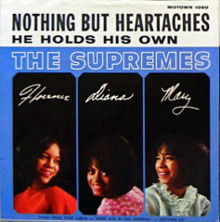Nothing_but_Heartaches
Nothing but Heartaches
1965 single by The Supremes
"Nothing but Heartaches" is a 1965 song recorded by The Supremes for the Motown label.[1]
This article needs additional citations for verification. (September 2016) |
| "Nothing but Heartaches" | ||||
|---|---|---|---|---|
 | ||||
| Single by The Supremes | ||||
| from the album More Hits by The Supremes | ||||
| B-side | "He Holds His Own" | |||
| Released | July 16, 1965 (1965-07-16) | |||
| Recorded | Hitsville U.S.A. (Studio A); May 13 and May 17, 1965 | |||
| Genre | Pop, R&B | |||
| Length | 2:55 | |||
| Label | Motown M 1080 | |||
| Songwriter(s) | Holland–Dozier–Holland | |||
| Producer(s) | ||||
| The Supremes singles chronology | ||||
| ||||
| More Hits by The Supremes track listing | ||||
12 tracks
| ||||
| Audio sample | ||||
"Nothing but Heartaches" | ||||
Written and produced by Motown songwriting and producing team Holland–Dozier–Holland, it was notable for breaking the first string of five consecutive number-one pop singles in the United States, peaking at number 11 from August 29, 1965, through September 4, 1965 on the Billboard Hot 100 chart.[2] Despite this, it was the sixth of seven consecutive million-selling singles released by The Supremes between 1964 and 1965.[3]
Recording
By the spring of 1965, The Supremes had elevated from regional R&B favorites to an internationally successful pop group thanks to a series of five singles which consecutively topped the United States Billboard pop charts: "Where Did Our Love Go", "Baby Love", "Come See About Me", "Stop! In the Name of Love" and "Back in My Arms Again." Known for creating repetitive follow-ups, Motown at this time was relying on a formula to create songs with a similar sound present in records by The Temptations, The Four Tops and Marvin Gaye among other recording acts.
Confident that they had finally found a successful formula, Berry Gordy had Holland–Dozier–Holland created a song similar to several of their earlier hit singles. As expected, "Nothing but Heartaches" had a similar sound to "Stop! In the Name of Love" and "Back in My Arms Again." Gordy felt confident that the song would become their sixth consecutive number-one hit.
Reception
The lukewarm response to "Nothing but Heartaches" was not what Gordy had predicted, as it peaked at number eleven on the Billboard Hot 100. The song's more modest top 20 charting prompted Gordy to circulate a memo around the Motown offices:
We will release nothing less than Top Ten product on any artist; and because the Supremes' world-wide acceptance is greater than the other artists, on them we will only release number-one records.
After canceling the planned subsequent release of "Mother Dear," Holland-Dozier-Holland produced "I Hear a Symphony."
Cash Box described the song as a "rollicking pop-blues heart-throbber about a love struck gal who can’t break away from a fella who is decidedly wrong for her."[4] Record World said that "The oh so sweet Diana Ross voice again wails as Florence Ballard and Mary Wilson chant along on a Detroit delight."[5]
- Lead vocals by Diana Ross
- Background vocals by Florence Ballard and Mary Wilson .
- Instrumentation by the Funk Brothers
- Baritone saxophone by Mike Terry[6]
Weekly charts
|
Year-end charts
|
| Region | Certification | Certified units/sales |
|---|---|---|
| United States | — | 1,000,000[3][19] |
- Steel, Bert (20 August 1965). "Bob Dylan's Lyrics Catchy on New Disc". Windsor Star. Retrieved 26 March 2011.
- "Billboard Hot 100". Billboard. Vol. 77, no. 36. Nielsen Company. 1965. p. 36. Retrieved 10 May 2011.
- Unknown Millionaires continued. Vol. 35. Johnson Publishing Company. April 1980. p. 136. ISSN 0012-9011. Retrieved 24 January 2020.
{{cite book}}:|work=ignored (help) - "CashBox Record Reviews" (PDF). Cash Box. July 31, 1965. p. 12. Retrieved 2022-01-12.
- "Single Picks of the Week" (PDF). Record World. July 31, 1965. p. 1. Retrieved 2023-07-21.
- Liner notes. The Complete Motown Singles Vol. 5: 1965, Hip-O Select – B0006775-02, USA, 04 Aug 2006
- "Vísir - 206. Tölublað (11.09.1965)". Vísir (in Icelandic). 11 September 1965. p. 11. Retrieved 8 January 2021.
- "Billboard HITS OF THE WORLD". Billboard. 13 November 1965. p. 28.
- "R&B SINGLES" (PDF). Record Mirror. September 11, 1965. p. 11. Retrieved January 28, 2022 – via worldradiohistory.com.
- "CASH BOX Top 100 Singles". Cashbox. September 11, 1965. Retrieved 31 December 2020.
- "The CASH BOX Top 50 In R&B Locations". Cashbox. September 18, 1965. Retrieved 31 December 2020.
- "100 TOP POPS: Week of September 4, 1965" (PDF). Record World. worldradiohistory.com. September 4, 1965. Retrieved 29 January 2021.
- "TOP 40 R&B: Week of September 4, 1965" (PDF). Record World. worldradiohistory.com. September 4, 1965. p. 21. Retrieved 29 January 2021.
- "The CASH BOX Year-End Charts: 1965". Cashbox. Retrieved 31 December 2020.
- "The CASH BOX Year-End Charts: 1965". Cashbox. Retrieved 31 December 2020.
- Joseph Murrells (1984). Million Selling Records from the 1900s to the 1980s: An Illustrated Directory. London: B.T. Batsford. p. 215. ISBN 0-7134-3843-6.